Презентация History SpaceX онлайн
На нашем сайте вы можете скачать и просмотреть онлайн доклад-презентацию на тему History SpaceX абсолютно бесплатно. Урок-презентация на эту тему содержит всего 19 слайдов. Все материалы созданы в программе PowerPoint и имеют формат ppt или же pptx. Материалы и темы для презентаций взяты из открытых источников и загружены их авторами, за качество и достоверность информации в них администрация сайта не отвечает, все права принадлежат их создателям. Если вы нашли то, что искали, отблагодарите авторов - поделитесь ссылкой в социальных сетях, а наш сайт добавьте в закладки.
Презентации » Астрономия » History SpaceX
Оцените!
Оцените презентацию от 1 до 5 баллов!
- Тип файла:ppt / pptx (powerpoint)
- Всего слайдов:19 слайдов
- Для класса:1,2,3,4,5,6,7,8,9,10,11
- Размер файла:4.93 MB
- Просмотров:147
- Скачиваний:0
- Автор:неизвестен
Слайды и текст к этой презентации:
№1 слайд
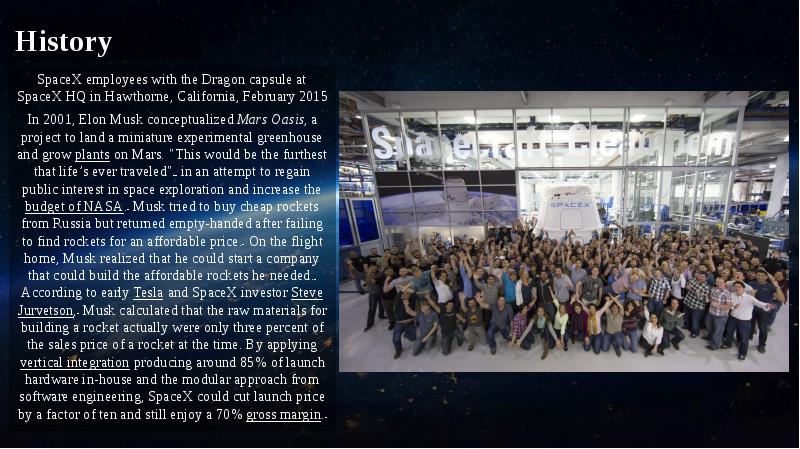

Содержание слайда: History
SpaceX employees with the Dragon capsule at SpaceX HQ in Hawthorne, California, February 2015
In 2001, Elon Musk conceptualized Mars Oasis, a project to land a miniature experimental greenhouse and grow plants on Mars. "This would be the furthest that life’s ever traveled" in an attempt to regain public interest in space exploration and increase the budget of NASA. Musk tried to buy cheap rockets from Russia but returned empty-handed after failing to find rockets for an affordable price. On the flight home, Musk realized that he could start a company that could build the affordable rockets he needed. According to early Tesla and SpaceX investor Steve Jurvetson, Musk calculated that the raw materials for building a rocket actually were only three percent of the sales price of a rocket at the time. By applying vertical integration producing around 85% of launch hardware in-house and the modular approach from software engineering, SpaceX could cut launch price by a factor of ten and still enjoy a 70% gross margin.
№2 слайд


Содержание слайда: In early 2002, Musk was seeking staff for his new space company, soon to be named SpaceX. Musk approached rocket engineer Tom Mueller (later SpaceX's CTO of Propulsion) and Mueller agreed to work for Musk, and thus SpaceX was born. SpaceX was first headquartered in a warehouse in El Segundo, California. The company has grown rapidly since it was founded in 2002, growing from 160 employees in November 2005 to 1,100 in 2010, 3,800 employees and contractors by October 2013, nearly 5,000 by late 2015, and about 6,000 in April 2017. As of November 2017, the company had grown to nearly 7,000. In 2016, Musk gave a speech at the International Astronautical Congress, where he explained that the US government regulates rocket technology as an "advanced weapon technology", making it difficult to hire non-Americans.
In early 2002, Musk was seeking staff for his new space company, soon to be named SpaceX. Musk approached rocket engineer Tom Mueller (later SpaceX's CTO of Propulsion) and Mueller agreed to work for Musk, and thus SpaceX was born. SpaceX was first headquartered in a warehouse in El Segundo, California. The company has grown rapidly since it was founded in 2002, growing from 160 employees in November 2005 to 1,100 in 2010, 3,800 employees and contractors by October 2013, nearly 5,000 by late 2015, and about 6,000 in April 2017. As of November 2017, the company had grown to nearly 7,000. In 2016, Musk gave a speech at the International Astronautical Congress, where he explained that the US government regulates rocket technology as an "advanced weapon technology", making it difficult to hire non-Americans.
№3 слайд
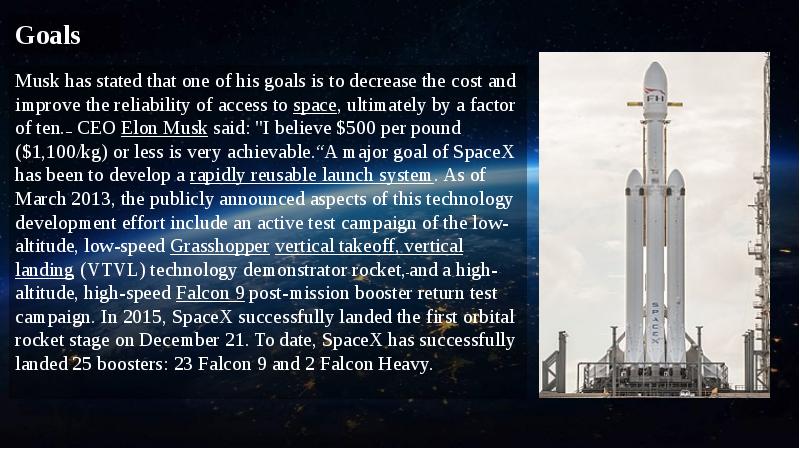

Содержание слайда: Goals
Musk has stated that one of his goals is to decrease the cost and improve the reliability of access to space, ultimately by a factor of ten. CEO Elon Musk said: "I believe $500 per pound ($1,100/kg) or less is very achievable.“A major goal of SpaceX has been to develop a rapidly reusable launch system. As of March 2013, the publicly announced aspects of this technology development effort include an active test campaign of the low-altitude, low-speed Grasshopper vertical takeoff, vertical landing (VTVL) technology demonstrator rocket, and a high-altitude, high-speed Falcon 9 post-mission booster return test campaign. In 2015, SpaceX successfully landed the first orbital rocket stage on December 21. To date, SpaceX has successfully landed 25 boosters: 23 Falcon 9 and 2 Falcon Heavy.
№4 слайд
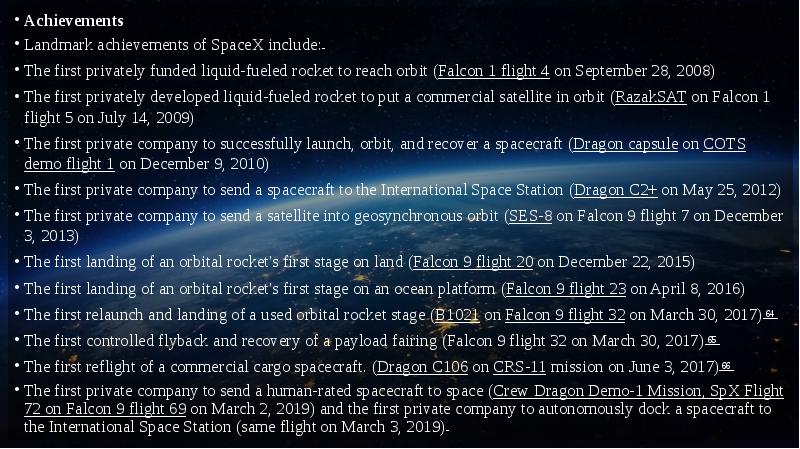

Содержание слайда: Achievements
Achievements
Landmark achievements of SpaceX include:
The first privately funded liquid-fueled rocket to reach orbit (Falcon 1 flight 4 on September 28, 2008)
The first privately developed liquid-fueled rocket to put a commercial satellite in orbit (RazakSAT on Falcon 1 flight 5 on July 14, 2009)
The first private company to successfully launch, orbit, and recover a spacecraft (Dragon capsule on COTS demo flight 1 on December 9, 2010)
The first private company to send a spacecraft to the International Space Station (Dragon C2+ on May 25, 2012)
The first private company to send a satellite into geosynchronous orbit (SES-8 on Falcon 9 flight 7 on December 3, 2013)
The first landing of an orbital rocket's first stage on land (Falcon 9 flight 20 on December 22, 2015)
The first landing of an orbital rocket's first stage on an ocean platform (Falcon 9 flight 23 on April 8, 2016)
The first relaunch and landing of a used orbital rocket stage (B1021 on Falcon 9 flight 32 on March 30, 2017) 64
The first controlled flyback and recovery of a payload fairing (Falcon 9 flight 32 on March 30, 2017) 65
The first reflight of a commercial cargo spacecraft. (Dragon C106 on CRS-11 mission on June 3, 2017) 66
The first private company to send a human-rated spacecraft to space (Crew Dragon Demo-1 Mission, SpX Flight 72 on Falcon 9 flight 69 on March 2, 2019) and the first private company to autonomously dock a spacecraft to the International Space Station (same flight on March 3, 2019)
№5 слайд


Содержание слайда: Ownership, funding and valuation
In August 2008, SpaceX accepted a $20 million investment from Founders Fund. In early 2012, approximately two-thirds of the company were owned by its founder and his 70 million shares were then estimated to be worth $875 million on private markets, which roughly valued SpaceX at $1.3 billion as of February 2012. After the COTS 2+ flight in May 2012, the company private equity valuation nearly doubled to $2.4 billion. In January 2015, SpaceX raised $1 billion in funding from Google and Fidelity, in exchange for 8.333% of the company, establishing the company valuation at approximately $12 billion. Google and Fidelity joined prior investors Draper Fisher Jurvetson, Founders Fund, Valor Equity Partners and Capricorn. In July 2017, the Company raised US$350m at a valuation of US$21 billion.
As of May 2012, SpaceX had operated on total funding of approximately $1 billion in its first ten years of operation. Of this, private equity provided about $200M, with Musk investing approximately $100M and other investors having put in about $100M (Founders Fund, Draper Fisher Jurvetson, ...). The remainder has come from progress payments on long-term launch contracts and development contracts. By March 2018, SpaceX had contracts for 100 launch missions, and each of those contracts provide down payments at contract signing, plus many are paying progress payments as launch vehicle components are built in advance of mission launch, driven in part by US accounting rules for recognizing long-term revenue.
№6 слайд
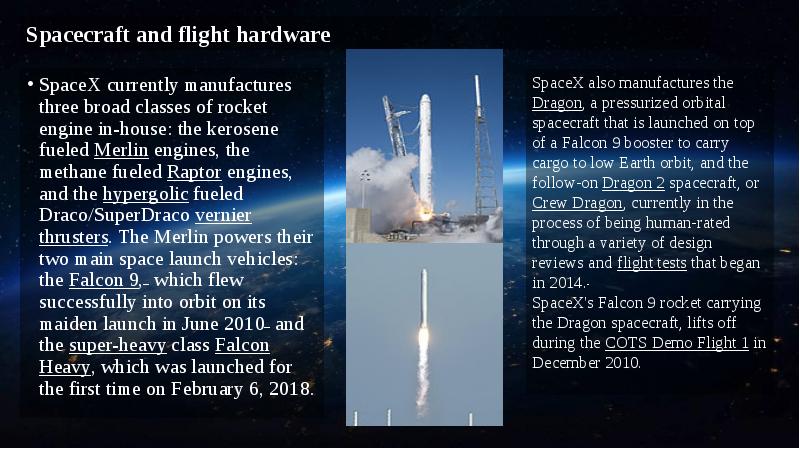

Содержание слайда: Spacecraft and flight hardware
SpaceX currently manufactures three broad classes of rocket engine in-house: the kerosene fueled Merlin engines, the methane fueled Raptor engines, and the hypergolic fueled Draco/SuperDraco vernier thrusters. The Merlin powers their two main space launch vehicles: the Falcon 9, which flew successfully into orbit on its maiden launch in June 2010 and the super-heavy class Falcon Heavy, which was launched for the first time on February 6, 2018.
№8 слайд
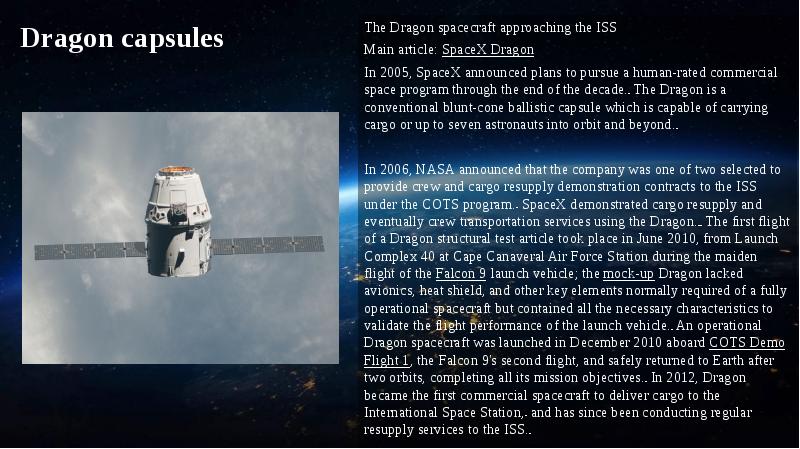

Содержание слайда: Dragon capsules
The Dragon spacecraft approaching the ISS
Main article: SpaceX Dragon
In 2005, SpaceX announced plans to pursue a human-rated commercial space program through the end of the decade. The Dragon is a conventional blunt-cone ballistic capsule which is capable of carrying cargo or up to seven astronauts into orbit and beyond.
In 2006, NASA announced that the company was one of two selected to provide crew and cargo resupply demonstration contracts to the ISS under the COTS program. SpaceX demonstrated cargo resupply and eventually crew transportation services using the Dragon. The first flight of a Dragon structural test article took place in June 2010, from Launch Complex 40 at Cape Canaveral Air Force Station during the maiden flight of the Falcon 9 launch vehicle; the mock-up Dragon lacked avionics, heat shield, and other key elements normally required of a fully operational spacecraft but contained all the necessary characteristics to validate the flight performance of the launch vehicle. An operational Dragon spacecraft was launched in December 2010 aboard COTS Demo Flight 1, the Falcon 9's second flight, and safely returned to Earth after two orbits, completing all its mission objectives. In 2012, Dragon became the first commercial spacecraft to deliver cargo to the International Space Station, and has since been conducting regular resupply services to the ISS.
№9 слайд


Содержание слайда: The interior of the COTS 2 Dragon
In April 2011, NASA issued a $75 million contract, as part of its second-round commercial crew development (CCDev) program, for SpaceX to develop an integrated launch escape system for Dragon in preparation for human-rating it as a crew transport vehicle to the ISS. In August 2012, NASA awarded SpaceX a firm, fixed-price SAA with the objective of producing a detailed design of the entire crew transportation system. This contract includes numerous key technical and certification milestones, an uncrewed flight test, a crewed flight test, and six operational missions following system certification. The fully autonomous Crew Dragon spacecraft is expected to be one of the safest crewed spacecraft systems. Reusable in nature, the Crew Dragon will offer savings to NASA.
№11 слайд


Содержание слайда: Interplanetary Transport System / BFR
Artist's impression of the Interplanetary Starship on the Jovian moon Europa.
Main article: SpaceX Mars transportation infrastructure
SpaceX is developing a super-heavy lift launch system, the BFR. The BFR is a fully reusable first stage launch vehicle and spacecraft intended to replace all of the company's existing hardware by the early 2020s, ground infrastructure for rapid launch and relaunch, and zero-gravity propellant transfer technology in low Earth orbit (LEO).
SpaceX initially envisioned the ITS vehicle design which was solely aimed at Mars transit and other interplanetary uses, SpaceX in 2017 began to focus on a vehicle support all SpaceX launch service provider capabilities: Earth-orbit, lunar-orbit, interplanetary missions, and even intercontinental passenger transport on Earth. Private passenger Yusaku Maezawa has been signed to fly around the Moon in the BFR rocket.
Musk's long term vision for the company is the development of technology and resources suitable for human colonization on Mars. He has expressed his interest in someday traveling to the planet, stating "I'd like to die on Mars, just not on impact." A rocket every two years or so could provide a base for the people arriving in 2025 after a launch in 2024. According to Steve Jurvetson, Musk believes that by 2035 at the latest, there will be thousands of rockets flying a million people to Mars, in order to enable a self-sustaining human colony.
№12 слайд
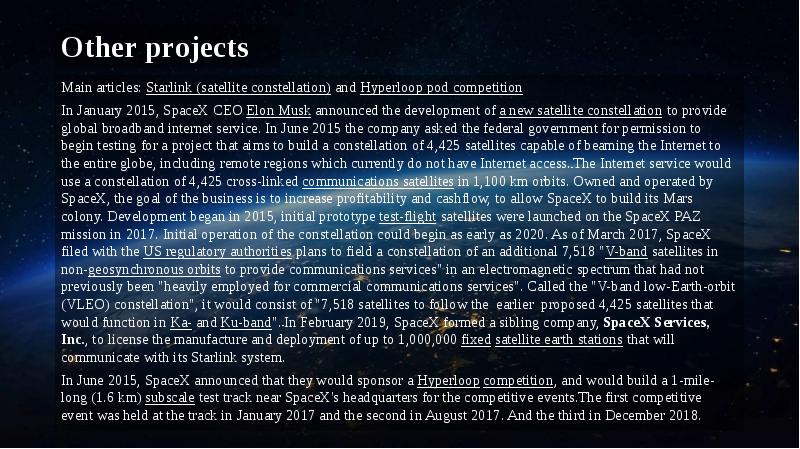

Содержание слайда: Other projects
Main articles: Starlink (satellite constellation) and Hyperloop pod competition
In January 2015, SpaceX CEO Elon Musk announced the development of a new satellite constellation to provide global broadband internet service. In June 2015 the company asked the federal government for permission to begin testing for a project that aims to build a constellation of 4,425 satellites capable of beaming the Internet to the entire globe, including remote regions which currently do not have Internet access. The Internet service would use a constellation of 4,425 cross-linked communications satellites in 1,100 km orbits. Owned and operated by SpaceX, the goal of the business is to increase profitability and cashflow, to allow SpaceX to build its Mars colony. Development began in 2015, initial prototype test-flight satellites were launched on the SpaceX PAZ mission in 2017. Initial operation of the constellation could begin as early as 2020. As of March 2017, SpaceX filed with the US regulatory authorities plans to field a constellation of an additional 7,518 "V-band satellites in non-geosynchronous orbits to provide communications services" in an electromagnetic spectrum that had not previously been "heavily employed for commercial communications services". Called the "V-band low-Earth-orbit (VLEO) constellation", it would consist of "7,518 satellites to follow the earlier proposed 4,425 satellites that would function in Ka- and Ku-band". In February 2019, SpaceX formed a sibling company, SpaceX Services, Inc., to license the manufacture and deployment of up to 1,000,000 fixed satellite earth stations that will communicate with its Starlink system.
In June 2015, SpaceX announced that they would sponsor a Hyperloop competition, and would build a 1-mile-long (1.6 km) subscale test track near SpaceX's headquarters for the competitive events.The first competitive event was held at the track in January 2017 and the second in August 2017. And the third in December 2018.
№13 слайд
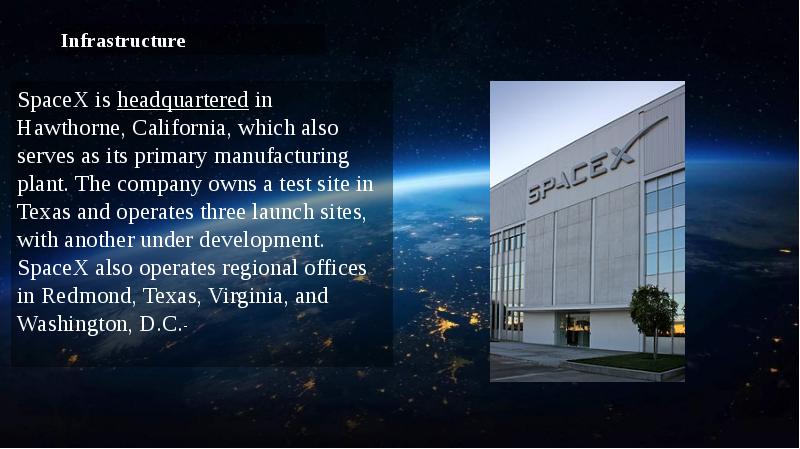

Содержание слайда: Infrastructure
SpaceX is headquartered in Hawthorne, California, which also serves as its primary manufacturing plant. The company owns a test site in Texas and operates three launch sites, with another under development. SpaceX also operates regional offices in Redmond, Texas, Virginia, and Washington, D.C.
№14 слайд
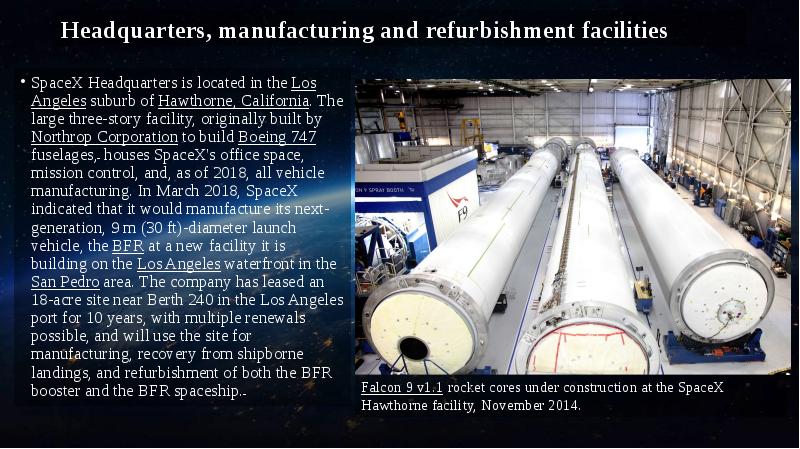

Содержание слайда: Headquarters, manufacturing and refurbishment facilities
SpaceX Headquarters is located in the Los Angeles suburb of Hawthorne, California. The large three-story facility, originally built by Northrop Corporation to build Boeing 747 fuselages, houses SpaceX's office space, mission control, and, as of 2018, all vehicle manufacturing. In March 2018, SpaceX indicated that it would manufacture its next-generation, 9 m (30 ft)-diameter launch vehicle, the BFR at a new facility it is building on the Los Angeles waterfront in the San Pedro area. The company has leased an 18-acre site near Berth 240 in the Los Angeles port for 10 years, with multiple renewals possible, and will use the site for manufacturing, recovery from shipborne landings, and refurbishment of both the BFR booster and the BFR spaceship.
№15 слайд
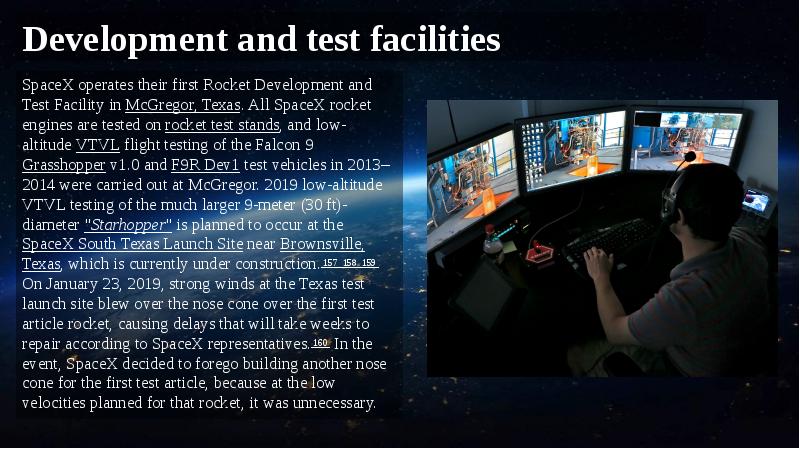

Содержание слайда: Development and test facilities
SpaceX operates their first Rocket Development and Test Facility in McGregor, Texas. All SpaceX rocket engines are tested on rocket test stands, and low-altitude VTVL flight testing of the Falcon 9 Grasshopper v1.0 and F9R Dev1 test vehicles in 2013–2014 were carried out at McGregor. 2019 low-altitude VTVL testing of the much larger 9-meter (30 ft)-diameter "Starhopper" is planned to occur at the SpaceX South Texas Launch Site near Brownsville, Texas, which is currently under construction. 157 158 159 On January 23, 2019, strong winds at the Texas test launch site blew over the nose cone over the first test article rocket, causing delays that will take weeks to repair according to SpaceX representatives. 160 In the event, SpaceX decided to forego building another nose cone for the first test article, because at the low velocities planned for that rocket, it was unnecessary.
№16 слайд
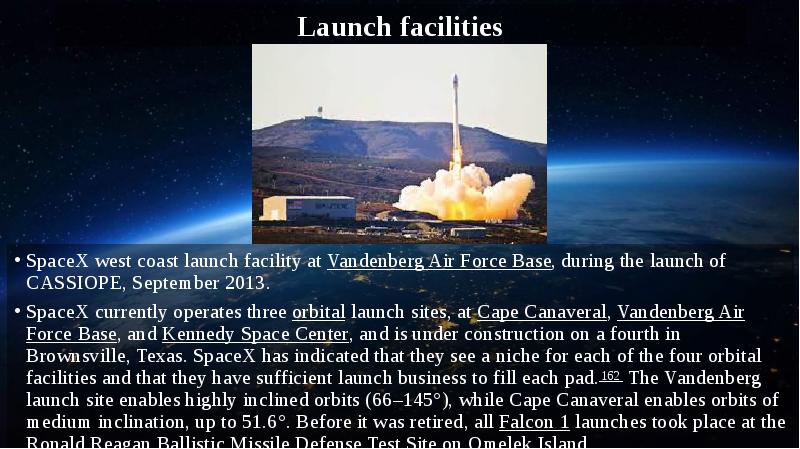

Содержание слайда: Launch facilities
SpaceX west coast launch facility at Vandenberg Air Force Base, during the launch of CASSIOPE, September 2013.
SpaceX currently operates three orbital launch sites, at Cape Canaveral, Vandenberg Air Force Base, and Kennedy Space Center, and is under construction on a fourth in Brownsville, Texas. SpaceX has indicated that they see a niche for each of the four orbital facilities and that they have sufficient launch business to fill each pad. 162 The Vandenberg launch site enables highly inclined orbits (66–145°), while Cape Canaveral enables orbits of medium inclination, up to 51.6°. Before it was retired, all Falcon 1 launches took place at the Ronald Reagan Ballistic Missile Defense Test Site on Omelek Island.
№17 слайд
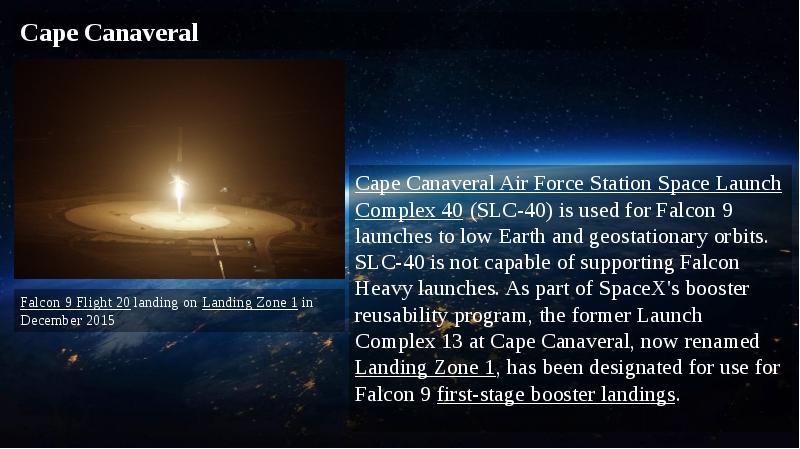

Содержание слайда: Cape Canaveral
Cape Canaveral Air Force Station Space Launch Complex 40 (SLC-40) is used for Falcon 9 launches to low Earth and geostationary orbits. SLC-40 is not capable of supporting Falcon Heavy launches. As part of SpaceX's booster reusability program, the former Launch Complex 13 at Cape Canaveral, now renamed Landing Zone 1, has been designated for use for Falcon 9 first-stage booster landings.
№18 слайд


Содержание слайда: COTS
The COTS 2 Dragon is berthed to the ISS by Canadarm2.
In 2006, NASA announced that SpaceX had won a NASA Commercial Orbital Transportation Services (COTS) Phase 1 contract to demonstrate cargo delivery to the ISS, with a possible contract option for crew transport.This contract, designed by NASA to provide "seed money" through Space Act Agreements for developing new capabilities, NASA paid SpaceX $396 million to develop the cargo configuration of the Dragon spacecraft, while SpaceX self-invested more than $500 million to develop the Falcon 9 launch vehicle. These Space Act Agreements have been shown to have saved NASA millions of dollars in development costs, making rocket development ~4-10 times cheaper than if produced by NASA alone.
In December 2010, the launch of the COTS Demo Flight 1 mission, SpaceX became the first private company to successfully launch, orbit and recover a spacecraft. Dragon was successfully deployed into orbit, circled the Earth twice, and then made a controlled re-entry burn for a splashdown in the Pacific Ocean. With Dragon's safe recovery, SpaceX became the first private company to launch, orbit, and recover a spacecraft; prior to this mission, only government agencies had been able to recover orbital spacecraft.
COTS Demo Flight 2 launched in May 2012, in which Dragon successfully berthed with the ISS, marking the first time that a private spacecraft had accomplished this feat.
№19 слайд
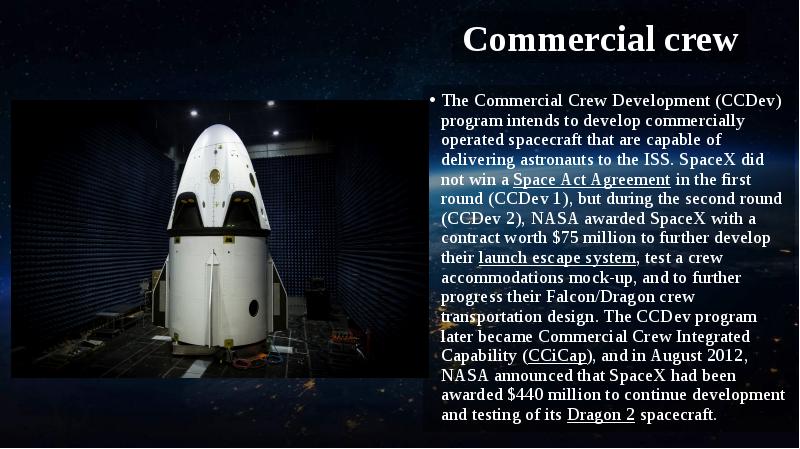

Содержание слайда: Commercial crew
The Commercial Crew Development (CCDev) program intends to develop commercially operated spacecraft that are capable of delivering astronauts to the ISS. SpaceX did not win a Space Act Agreement in the first round (CCDev 1), but during the second round (CCDev 2), NASA awarded SpaceX with a contract worth $75 million to further develop their launch escape system, test a crew accommodations mock-up, and to further progress their Falcon/Dragon crew transportation design. The CCDev program later became Commercial Crew Integrated Capability (CCiCap), and in August 2012, NASA announced that SpaceX had been awarded $440 million to continue development and testing of its Dragon 2 spacecraft.
Скачать все slide презентации History SpaceX одним архивом:











